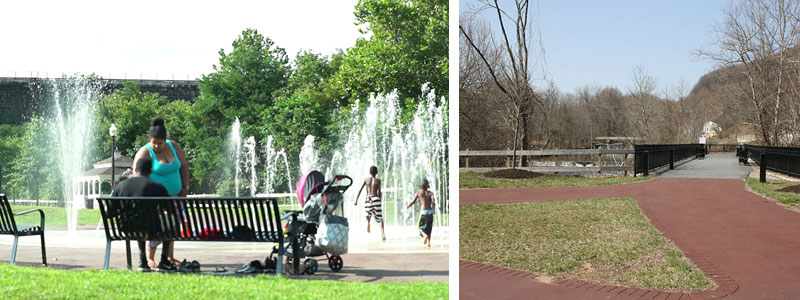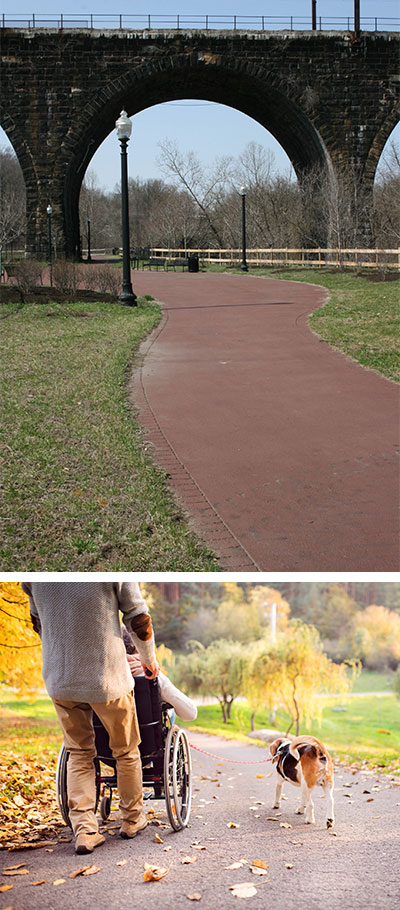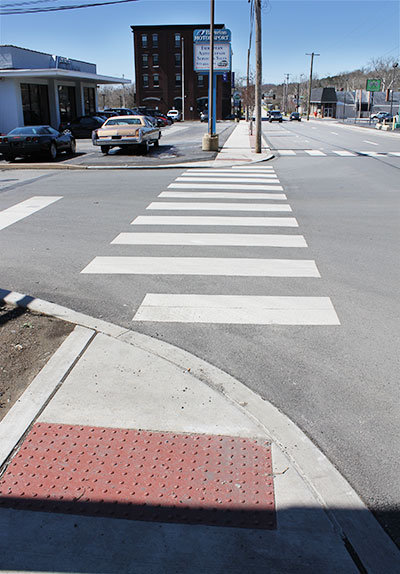Universally designed public spaces, such as the trail at Riverwalk Park in Coatesville (top), provide use opportunities for a range of ages and abilities.
How it Works
Universal design serves all ages and abilities by standardizing features such as wider sidewalks that are clear of obstructions, benches, no-step entryways, ramps, wider doorways and hallways, as well as by providing specialized features such as ADA pool access equipment. Such features can be incorporated into both exterior and interior public spaces.
Municipalities can implement universal design through promoting design concepts in long range planning and through potential revisions to building codes and zoning ordinances to request universal design features in public spaces. For information regarding universal design for residential uses, see Universal Design for Residential Uses.
The Center for Universal Design offers seven principles of universal design that apply to public spaces:
1. Equitable use
Spaces designed for equitable use allow a variety of users to easily utilize the same structure. For example: a universally designed playground should offer options of multi-generational play as well as opportunities for users of all physical and mental abilities.
2. Flexible use
Flexible uses accommodate a wide range of individual abilities and preferences, such as an adjustable height desk at a library which can be used from a seated or standing position.
3. Intuitive use
Intuitive uses are easily understood with minimal user experience, knowledge, or language skills. An example of this is simple signage which is easy for people of all ages to interpret.
4. Perceptible information
The use of perceptible information in universal design communicates necessary information regardless of the user's sensory abilities (such as sight or sound) and the surrounding ambient conditions (such as background noise or dim lighting). An example would be a raised, tactile warning alerting of an intersection or the edge of a train platform.
5. Tolerance for error
Designing in accordance with tolerance for error limits adverse consequences and hazards of unintended actions or accidents, such as a border along a trail which separates the surface trail from bordering wildlife or steep slopes. This border may account for tolerance of error for those who are physically unable to see or respond to potentially dangerous features while using the trail.
6. Low physical effort
Low physical effort designs permit for the equitable use for all individuals. An example of this is seamless transition surfacing for playgrounds or flooring in a public space.
7. Size and space for approach and use
Size and space for approach and use provides appropriately sized spaces for all users of varying body sizes, postures, and mobility. For example, an extra-wide paved trail would permit a variety of recreational uses for users of all abilities.
Benefits
Multi-generational use
Universal design accommodates individuals of all age ranges, which maximizes public use of community facilities. This can promote positive multi-generational social interaction.
Community character
Through its inclusive nature, universal design promotes positive community interaction for all individuals. Designing spaces for individuals of all age ranges and abilities creates accommodating spaces for individuals who may have previously been limited in their interaction with the community due to disability or other physical hardship.
Cost efficiency
The cost of adding universal design features to the construction of new public spaces is relatively low. While retrofitting features into existing spaces requires a greater expense, these features often present lasting value as the features accommodate all life stages and circumstances. Trails, public parks, libraries, or other community facilities are ideal spaces to implement universal design, from design through construction and retrofittings.
Features of public universal design, such as this accessible curb ramp and crosswalk in Kennett Square Borough are important to consider throughout the development process.
Get Started
Municipalities can promote a climate of encouraging universal design by highlighting it for the advancement of public health in their comprehensive plans. Other non-regulatory options which can be used to share universal design concepts and benefits include public outreach outlets such as public meetings discussing the use and optimization of public spaces in the community. Municipal development of multi-generational spaces to maximize public use of community facilities and facilitate positive multi-generational social interactions should be encouraged.
Municipalities have limited regulatory control over the inclusion of universal design features through their zoning and subdivision ordinances because these ordinances do not typically address interior building standards. However, municipalities can encourage opportunities for universal design in building codes and zoning and land development ordinances which establish standards for public spaces. Zoning and land development provisions should be evaluated to permit design features which promote the goals of universal design and to ensure that universal design features are not precluded based on current standards. Examples of features to evaluate through building code regulations include: step-free entrances, wider exterior doors and ground floor interior doors, accessible first-floor bathrooms, provision of benches, maximum slopes, and, setback relief for Americans With Disabilities Act building components.
Municipalities interested in promoting universal design may want to consider requiring universal design features in institutional type land uses such as nursing homes, and public facilities such as libraries, community centers, and parks.
Considerations
Cultural familiarity
Residents may be unaware of the term universal design and its goals, potentially limiting the marketability of universal design features when planning for public spaces.
Inclusive design
Incorporating design features which span the full needs of residents of all ages and abilities can be challenging. Care should be taken to ensure that design features appeal to diverse needs in the community and that these features are planned in a manner which limits conflicting user benefits.
Outreach
Promoting universal design requires communication between the community and a number of professionals in the fields of accessibility, planning, construction, and engineering. Means should be taken to seek information from those knowledgeable about the needs of persons with disabilities, the aging, and development professionals to ensure community needs are met.
Development cost
While universal design is beneficial to the community, developers may be hesitant to design for these features if their associated costs are unknown or thought to be burdensome.
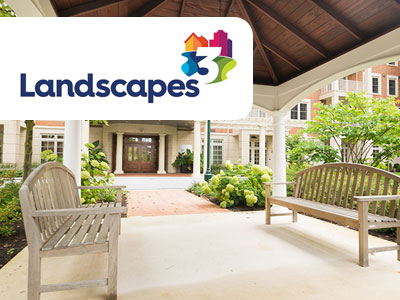
Universal Design: Comprehensive Plan
Landscapes3 identifies universal design as a priority in community planning and provides information on the importance of promoting universal design in housing and public spaces. A number of community partners knowledgeable in universal design and aging in place are identified and community partnership is encouraged. Chester County municipalities can further promote the principles of universal design through their own community comprehensive plans which can address specific opportunities and concerns in the community.
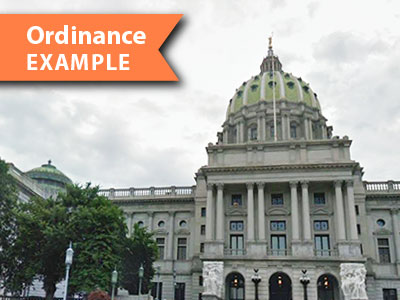
Universal Design: Ordinance
The State of Pennsylvania Department of Labor and Industry's Universal Accessibility Regulations ordinance establishes accessibility standards including standards for public spaces. This ordinance provides provisions for the addition of accessible features in the new construction and major renovation of public spaces and buildings.
Exton Train Station (West Whiteland Township)
Renovations have been made to the Exton train station to provide universal design features. The renovations include an accessible elevated platform for transit riders, allowing riders to enter SEPTA and Amtrak trains at grade, rather than having to step up and into the train car. Other improvements include wide train platforms, elevators and access ramps, and pedestrian amenities such as an overhead canopy and benches.

Riverwalk Park (Coatesville)
The Riverwalk Park in Coatesville offers a number of recreational options for individuals of all ages and abilities. The park, which is located along the Brandywine Creek, features an accessible 10-foot wide paved trail providing access for pedestrians, cyclists, and other multimodal options. Other features of universal design include areas with benches for pedestrians and an accessible children's splash pad.
